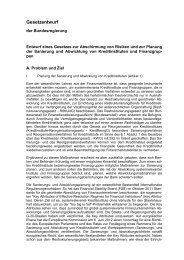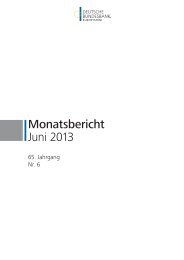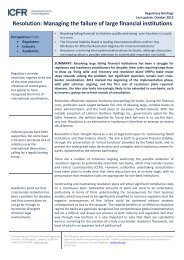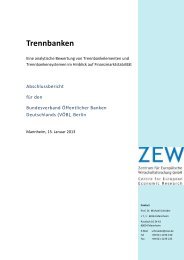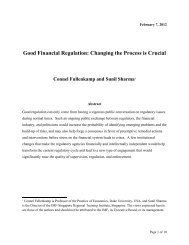Financial Stability Report - Financial Risk and Stability Network
Financial Stability Report - Financial Risk and Stability Network
Financial Stability Report - Financial Risk and Stability Network
Create successful ePaper yourself
Turn your PDF publications into a flip-book with our unique Google optimized e-Paper software.
26<br />
action undertaken by the Bank of Italy regarding the quality of bank assets with a view to checking<br />
the adequacy of coverage ratios (see the box “e recent check on the quality of Italian banks’<br />
assets”). A recent Bank of Italy supervisory communication on the occasion of the approval of the<br />
nancial statements for 2012 reminded banks of the importance of having their provisions reect<br />
the present <strong>and</strong> prospective performance of the economy. 3 To minimize possible procyclical eects,<br />
banks were asked to increase internally generated funds by curbing costs <strong>and</strong> adopting dividend<br />
distribution policies consistent with their own solvency condition <strong>and</strong> operating performance. e<br />
criteria for director <strong>and</strong> executive compensation must also be compatible with the objective of<br />
bolstering banks’ soundness.<br />
e strengthening of the banks at which the Bank of Italy’s supervisory action aims is essential to<br />
maintain a high level of investor condence, attract outside nancing <strong>and</strong> ensure an adequate ow of<br />
credit to households <strong>and</strong> rms.<br />
3 e communication of 13 March 2013 is published in Bollettino di Vigilanza, No. 3, 2013, available on the Bank of Italy’s website.<br />
THE RECENT CHECK ON THE QUALITY OF ITALIAN BANKS’ ASSETS<br />
e recession is imposing high credit risk on banks. The Bank of Italy is conducting an assessment<br />
of the adequacy of provisioning by an ample set of large <strong>and</strong> medium-sized banking groups.<br />
Where necessary, the Bank requires corrective action to be taken.<br />
Initially, in 2012 the checks were conducted off-site, using statistical methodologies to identify<br />
banks whose loss provisions were deemed unsatisfactory. For each banking group, homogeneous<br />
portfolios – in terms of the type of impairment (bad debts, subst<strong>and</strong>ard loans, restructured<br />
loans), collateral <strong>and</strong> the borrower’s sector of activity – were assessed. For each portfolio,<br />
where significant divergence between the effective coverage ratio <strong>and</strong> the system-wide average<br />
was found, additional capital buffers were required under Basel pillar 2. These requirements<br />
helped to determine the specific target or minimum trigger capital ratio for each of the groups<br />
considered.<br />
Last autumn the Bank of Italy also undertook a programme of inspection of 20 large <strong>and</strong><br />
medium-sized banking groups, selected on the basis of coverage ratios <strong>and</strong> the results of<br />
statistical analysis. The inspections assess the banks’ policies for coping with the increase in<br />
non-performing loans, their internal procedures for calculating loan loss provisions, <strong>and</strong> the<br />
adequacy of these provisions. The inspections will be completed by the middle of this year.<br />
For each intermediary, two samples of impaired loans were inspected. A first set of nonperforming<br />
exposures, called the targeted sample (accounting on average for 20 per cent of bad<br />
debts, 30 per cent of subst<strong>and</strong>ard loans <strong>and</strong> 50 per cent of restructured loans), was examined<br />
in detail by the Bank’s inspectors. A second sample, called statistical, representative of the bad<br />
debt portfolio <strong>and</strong> accounting on average for 15 per cent of the total, was analysed by each<br />
bank’s internal audit, subject to subsequent verification by the inspection team. Overall, the<br />
checks covered about 80 per cent of the banking system’s bad debts plus a significant share of<br />
subst<strong>and</strong>ard <strong>and</strong> restructured loans.<br />
The results of the inspections were partly incorporated in the banks’ balance sheets for 2012.<br />
Intermediaries were also asked to prepare measures for continuous checking of the adequacy of<br />
their coverage ratios. As regards the bad debts within the targeted sample analysed directly by the<br />
inspectors, the adjustment of loss provisions has produced a signicant increase in the coverage<br />
ratio.<br />
<strong>Financial</strong> <strong>Stability</strong> <strong>Report</strong> No. 5, April 2013 BANCA D’ITALIA



